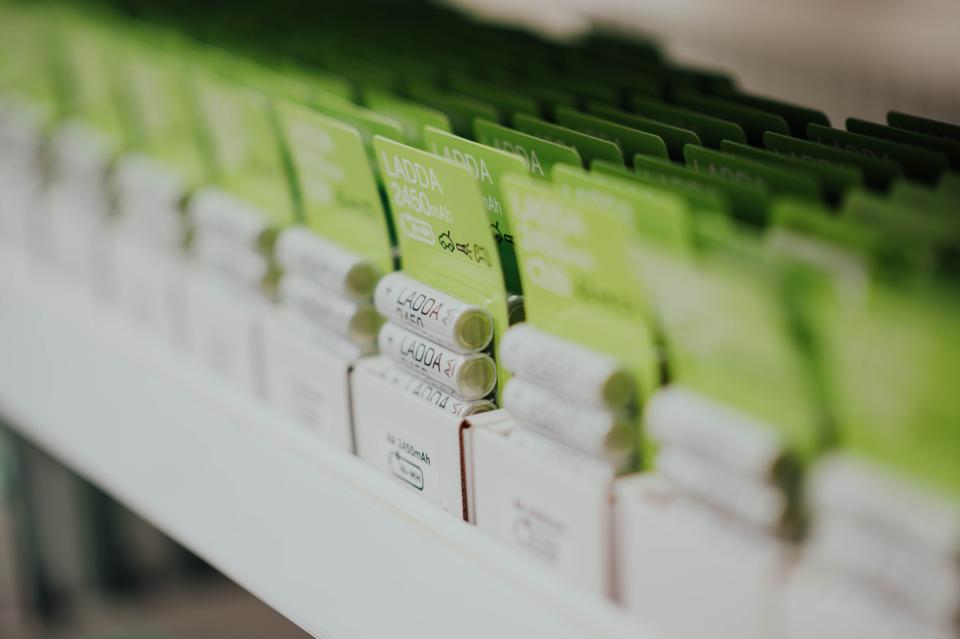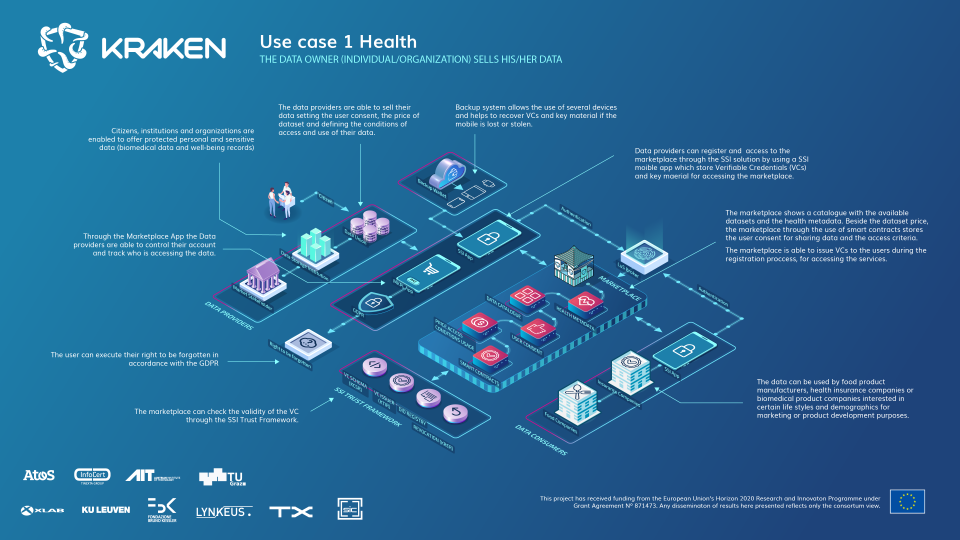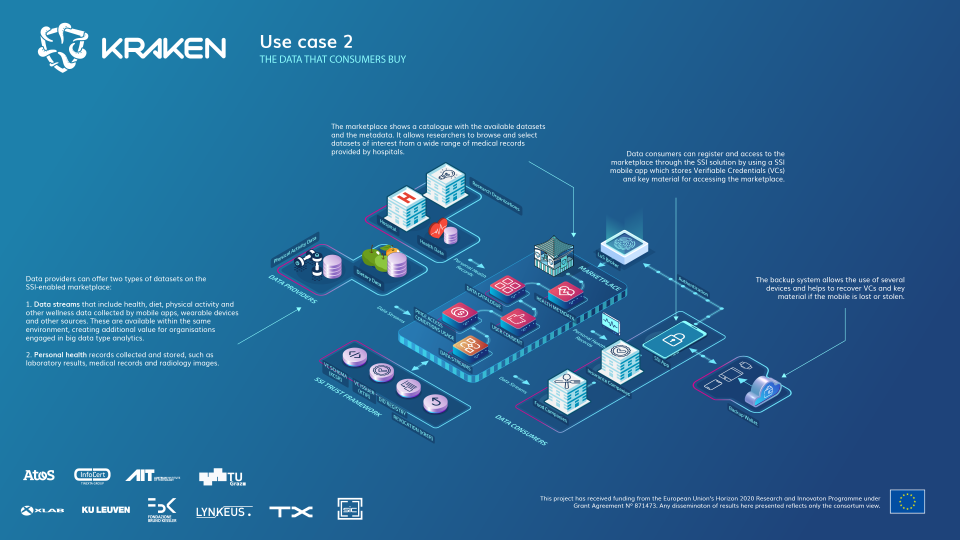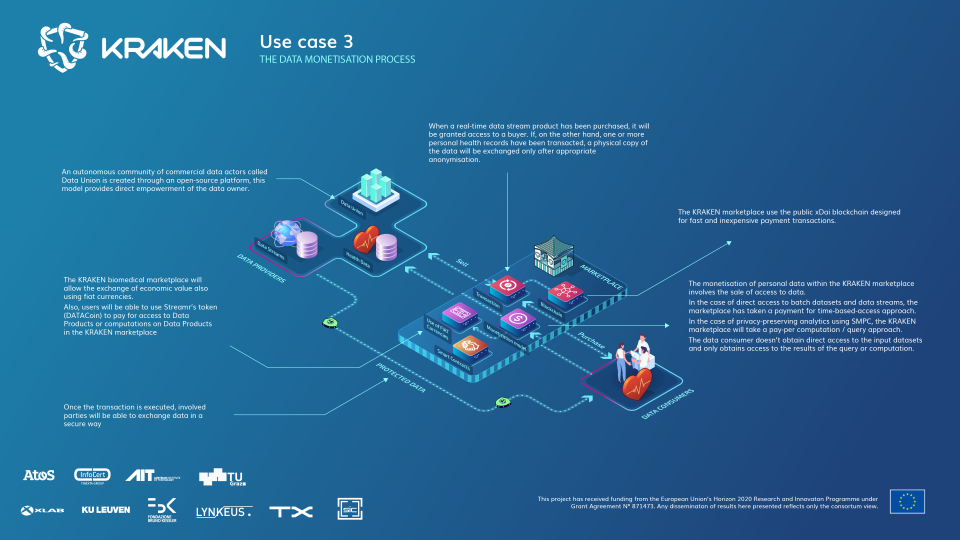A health and wellness data marketplace for individuals and organisations.
Leveraging the established data platforms of the H2020 MyHealthMyData (MHMD) and Streamr projects, KRAKEN will develop a biomedical data marketplace for individual citizens and healthcare organisations, where it will be possible to commercialize patient medical records and real-world, wellbeing data streams from wearable devices, in full compliance with GDPR.

KRAKEN is developing a biomedical and wellness data marketplace that connects individual citizens and healthcare organisations, and shares medical and wellness data streams with data consumers, such as academic research centres, health-tech companies, insurers, public authorities and wellbeing service providers, in exchange for economic value.
The platform will leverage existing blockchain data infrastructures of the H2020 MyHealthMyData (MHMD) and Streamr projects, and the trading will involve personal health records including lab results, medical histories and radiology images, and health and wellbeing, real-world data such as heart rate, dietary, physical activity, recorded by from mobile apps and other wearable devices.
Objectives
Developing a technical solution enabling citizens and healthcare organisations to:
- Fully control what data is shared, with whom and for what purpose.
- Make the data from their devices discoverable to interested parties.
- Deliver their data from their devices to those who want it in a simple way.
- Receive a share of the value of the data they are producing.
Benefits & beneficiaries
- Data providers: individual citizens and healthcare centres (hospitals) will be able to control and regulate the use of the data they generate and be equally rewarded for that, increasing awareness of their rights and liabilities as data controllers and sharing the economic benefit deriving from data usage.
- Data users: academic research centres, health-tech companies, insurers, public authorities, and wellbeing service providers. All of them will be able to gain access to high-quality aggregated data for their work in a unprecedented straightforward and seamless way, being able to extract maximum value from data, in turn benefiting society by creating added economical value as well as accelerating the pace of data-driven research and technological innovation in the biomedical field.
Challenges
- Achieving seamless aggregation, curation and harmonisation of heterogeneous data sources.
- Reaching full data interoperability between different systems.
- Maximising data discoverability by implementing an efficient data catalogue.
- Developing user experiences and interfaces intuitive enough to allow effective utilization by non-expert users.
Infographics
UC1 The data owner (individual/organization) sells his/her data
Data Providers (e.g., citizens, institutions and organizations) are able to sell their data setting the user consent, the price of dataset and defining the conditions of access and use of their data. This information is stored by using smart contracts. The user can execute their right to be forgotten in accordance with the GDPR.
Data Providers (DPs) access to the marketplace leveraging an SSI mobile app which stores Verifiable Credentials (VCs) and key material for accessing the marketplace.
USE CASE #1: Data owner (individual/organisation) sells their data
UC2 The data consumers purchases data
Data Providers can offer two types of datasets on the SSI-enabled marketplace:
- Data streams including health, diet, physical activity and other wellness data collected by mobile apps, wearable devices and other sources.
- Personal health records collected and stored, such as laboratory results, medical records and radiology images.
The marketplace shows a catalogue with the available datasets and the metadata. It allows consumers to browse and select datasets of interest.
Data consumers can register and access to the marketplace through the SSI mobile app which stores Verifiable Credentials (VCs) and key material for accessing the marketplace.
UC3 The data monetization process
An autonomous community of commercial data actors called Data Union is created through an open-source platform, this model provides direct empowerment of the data owner. The KRAKEN marketplace will allow the exchange of economic value primarily using Streamr's token DATACoin to pay for access to Data Products or computations on Data Products.
The KRAKEN marketplace uses the public xDai blockchain designed for fast and inexpensive payment transactions.
The monetisation of personal data within the KRAKEN marketplace involves the sale of access to data. In the case of privacy-preserving analytics using SMPC (Secure Multi-Party Computation), the KRAKEN marketplace will take a pay-per computation / query approach.
UC4 Data Analytics as a service (DAaaS)
Data consumers will be able to pay for standard set of fixed analytics queries (e.g., Average, Standard deviation, Min and Max) on the data advertised in the marketplace. The results are returned to the consumer when payment is confirmed, without granting direct access to the data. Analytics service providers will be able to leverage KRAKEN in two different ways for two different processes: refinement of analytics services and marketing of analytics as a service.
Services providers will be able to leverage the KRAKEN platform to offer their tools to data consumers, opening up the prospect of an additional blockchain-driven market for analytics services, enabling direct monetisation on a per-use basis.
Video demo
The demonstration of the different use cases of the health and education pilots have been recorded for dissemination purpose. Besides these use cases, recordings related to processes and components developed during the KRAKEN lifetime not included in the described use cases, are presented as well.
USE CASES
UC1 The data owner (individual/organization) sells his/her data
Data provider publishes health data
User acting in behalf of an organization



